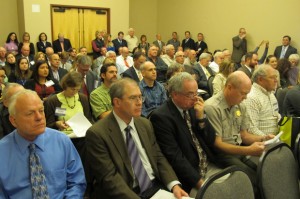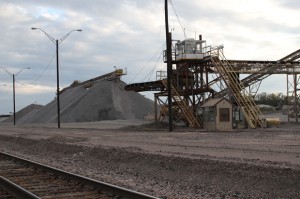After Decade of Consideration, State Caps Withdrawals from Oklahoma’s Most Sensitive Aquifer
-
Logan Layden

Logan Layden / StateImpact Oklahoma
A larger than usual crowd packs the OWRB's monthly meeting in Midwest City to hear the board vote Wednesday afternoon.
Supporters let out a big cheer Wednesday after the Oklahoma Water Resources Board voted to cap the amount of water that can be taken from the Arbuckle-Simpson Aquifer, the source of drinking water for communities across a large area of south-central Oklahoma.
The decision was 10 years in the making, and came about — in part — because some landowners were concerned that limestone and sand mining was draining the aquifer too quickly.
Digging a quarter-mile wide hole hundreds of feet deep displaces a lot of aquifer water. And if the water level of the aquifer drops below where it enters streams and springs, towns like Ada, Tishomingo and Davis will have to find another source.
So in 2003, area legislators set out to make sure that didn’t happen. A law was passed that ordered the water board to determine how much water could safely be removed from the Arbuckle-Simpson without disturbing those springs and streams.
“For the first time ever, the state legislature recognized the connections between groundwater and surface water,” OWRB Executive Director J.D. Strong says. “It takes a long time — first of all — just to do a sophisticated study of this magnitude.”
The study took about six years, but finally, in March 2012, the OWRB had its number: .2 acre-feet per year — or about 65,000 gallons of water per acre of land.
Mining Takes a Hit
Jim Rodriguez with the Oklahoma Aggregates Association, which represents the mining industry, has been fighting this proposal at every turn. He thinks the .2 acre-feet limit would hurt the limestone and sand miners on the aquifer.
“During times of drought like we’ve been in, we feel like that would be quite a challenge,” Rodriguez says. “We’ll have to be on our toes.”
He says there are lots of problems with the OWRB study, and that drought is to blame for drying up springs and streams that flow out of the Arbuckle-Simpson. But landowner Shannon Shirley blamed mining or the disruption of the creek she relies on when StateImpact visited her property last summer.

Logan Layden / StateImpact Oklahoma
A pile of crushed limestone sits near the train tracks at Texas Industry's large mining operation near Mill Creek, Okla.
“When we first moved down here, we had tons of water,” Shirley says. “We had enough water that we could put a paddleboat in this creek. Now we can’t even put a canoe on it.”
Saving the Aquifer or Stealing Water?
But the limit won’t just apply to the mining industry. It goes for everyone who has a permit to use water from the Arbuckle-Simpson. And while some landowners, like Shirley, strongly support the water board’s effort, others see it as outright theft of water they’ve been using for years. James Barnett is an attorney for a group of landowners opposed to the limit.
“The reality is that .2 is not enough water to do anything with,” Barnett says. “The water board has said, ‘well you need about 2 acre-feet per year for irrigation.’ They’re giving them 2 tenths of that, so you can’t even irrigate with the amount of water they’re leaving them. You can’t do anything with it.”
He can’t understand why cities and towns that need the aquifer’s water would support the limit, but they are. Former Ada Mayor Dick Scalf makes the case very simply:
“You can’t take out more than goes in there. Ada will have to buy additional water rights,” Scalf says.
That won’t make water bills any cheaper. But J.D. Strong ways the OWRB only did what the legislature told it to: Determine how much water is too much to take from the aquifer. And he’s supremely confident in that .2 acre-feet number.
“There was a lot more time, a lot more money, a lot more scientists and research and effort that went into developing the models, the science, the data to support this maximum annual yield.”
Like it or not, that’s the rule — for now. The water board’s decision can be appealed, so the fight over the Arbuckle-Simpson Aquifer might not be finished yet.
